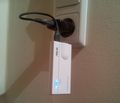A little rant today on new buildings and coverage issues as I keep hearing such reports with increasing frequencies:
When GSM was launched in the 1990's the windows of most buildings were made of glass and while there was some signal loss through them, by and large things worked pretty well. Over the last couple of years however, new buildings, especially offices, are equipped with heat insulating windows that don't only keep the heat or cold out but also radio waves. Their effect is pretty dramatic. Excellent coverage outside the building, no coverage whatsoever inside the building. Hotels, offices, shopping malls, you name it, it's getting more difficult to get coverage into those buildings from macro cells on the outside. While shopping malls are often equipped with indoor coverage via repeaters or small cells, hotels and office buildings or usually not. An exception I have noticed are 4+ star hotels in Asia while their European counterparts usually don't bother. Sure, there are solutions for this that work great such as repeaters, distributed antenna systems, small cells, femto cells, etc. but they all require active interaction between network operators and the owner of the buildings, i.e. extra work. Extra work many building owners are so far unwilling to do. I wonder how much critical mass it will take in terms of new buildings before network operators are taking a pro-active approach to this!?


